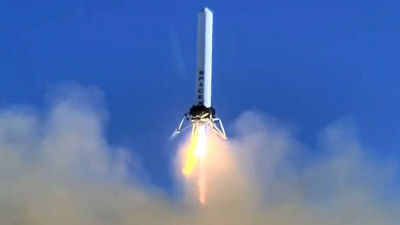SpaceX conducts Starship's fifth test flight, successfully catches booster on launch tower

SpaceX, an aerospace company led by Elon Musk, conducted a test launch of the world's largest rocket, Starship , on October 13, 2024 local time. In this fifth test, the booster part, Super Heavy, was successfully caught on the launch pad.
- SpaceX - Launches
https://www.spacex.com/launches/mission/?missionId=starship-flight-5
Starship's Fifth Flight Test/X
https://x.com/i/broadcasts/1RDGlyognOgJL
The rocket used in this test launch was a large one, measuring 121m in length, with a Super Heavy first stage and Starship second stage.
Liftoff of Starship! pic.twitter.com/WyNRN1fLbd
— SpaceX (@SpaceX) October 13, 2024
Two minutes and 44 seconds after launch, Super Heavy separated at an altitude of 71 km and began its fall to Earth.
Starship hot-staging separation pic.twitter.com/6tRw2OjtMm
— SpaceX (@SpaceX) October 13, 2024
About seven minutes after launch, Super Heavy reached its designated position and was firmly held in place by the two arms named 'Mechazilla.'
Mechazilla has caught the Super Heavy booster! pic.twitter.com/6R5YatSVJX
— SpaceX (@SpaceX) October 13, 2024
Footage from a super heavy perspective.
Onboard view showing a catch fitting on Super Heavy as it contacts a chopstick catch beam pic.twitter.com/r1TVQEdITc
— SpaceX (@SpaceX) October 14, 2024
Below is a shot of the catch from the launch tower's perspective.
Tower view of the first Super Heavy booster catch pic.twitter.com/Bgjeyuw7Hf
— SpaceX (@SpaceX) October 14, 2024
Next, the Starship, which continued flying to the other side of the Earth, began its descent toward Earth about 33 minutes after launch. Below is the Starship re-entering the atmosphere.
Views brought to you by @Starlink pic.twitter.com/34VK16OsoH
— SpaceX (@SpaceX) October 13, 2024
Approximately one hour and five minutes after launch, Starship successfully landed at its target site in the Indian Ocean.
Splashdown confirmed! Congratulations to the entire SpaceX team on an exciting fifth flight test of Starship! pic.twitter.com/FhCGznq9RO
— SpaceX (@SpaceX) October 13, 2024
SpaceX said of the successful launch, 'This is a remarkable engineering feat and a major leap forward in our goal of bringing life to another planet.'
Musk also said, 'We inspected the Super Heavy upon its return to the launch tower and found that some of the engine nozzles were distorted due to overheating and other minor issues, but these are easily remedied.'
Just inspected the Starship booster, which the arms have now placed back in its launch mount. Looks great!
— Elon Musk (@elonmusk) October 14, 2024
A few outer engine nozzles are warped from heating & some other minor issues, but these are easily addressed.
Starship is designed to achieve reflight of its rocket… pic.twitter.com/oWZoOOfHmk
According to SpaceX, the previous commercial launch rocket ' Falcon 9 ' was able to land on the legs at the bottom of the rocket, but if this structure was adopted for the even larger Super Heavy, the transportation efficiency of the cargo load would deteriorate. Therefore, by catching the booster on a launch pad like this one, it is possible to increase transportation efficiency and reduce launch costs.
The figure below shows the orbital launch costs of successive rockets since 1960. SpaceX's rockets are surrounded by dotted lines, and you can see that the orbital launch cost has improved tremendously since Falcon 1. The orbital launch cost of Starship is estimated at $200 (about 30,000 yen) per kilogram of payload, and 'the cost of launching a spacecraft has fallen by a factor of 10 over the past decade.'
There could never be a space economy without low-cost flights.
— Crémieux (@cremieuxrecueil) October 14, 2024
The plain fact of the matter is that SpaceX has enabled the existence of the space economy. pic.twitter.com/DJgltk6P3V
Related Posts:







